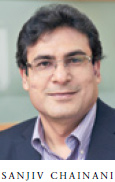
… and it’s time to buy now
These days, every discussion on the trend of the market ends up in a conclusion that markets are expensive and are bound to correct. This argument is based on the premise that markets have been running up too fast without any meaningful correction from February 2016 lows and is now quoting at high P/E multiples. It is also argued that markets are trading at a substantial premium to other emerging markets.
The NIFTY 50 is quoting at a P/E multiple of 23.6 times. In January 2008, the markets topped out when the P/E multiple was at 28.3 times. Historically, markets usually tend to top out at 23-28 P/E multiples. Let us see if it is right to conclude that markets are trading at frothy valuations based on just one criteria – the P/E multiple.
At the top of the business cycle in 2007-08, corporate capex was at its peak owing to record high capacity utilisation levels. Earnings had been growing consistently at over 20 per cent for the past three years. The scenario is different now. Corporates are still not ready with a fresh round of capex, as capacity utilisation continues to remain low at about 70 per cent. Infrastructure spend is primarily in the form of government spending for public infrastructure. This situation is about to change, as the corporate sector focuses on deleveraging their balance sheets, preparing for the next round of growth. Most large corporates share optimism about the potential of India’s economy because of the strong leadership at the Centre. This is reflected in the fact that the promoters of one-fifth of the BSE 500 companies have raised stakes, indicating their confidence in their company’s growth
(source: The Economic Times).
The credit growth in the economy continues to remain sluggish at about 10 per cent, as against the mid-20s as in 2007-08. The banking sector in India is undergoing a major clean-up exercise, which will build the stage for the next round of economic growth.
P/E multiples on an absolute basis tend to look stretched during the phase, when the economy is at the cusp of a major recovery, while corporate earnings are yet to show meaningful growth. India is going through such a phase now. The current high P/E multiples are just an indication that investors anticipate strong and sustainable growth in earnings in the years to come.
Market valuations are not looking extremely stretched based on other valuation metrics such as price to book (P/B) and dividend yield. On a P/B basis, NIFTY 50 is quoting at 3.3 times as against 6.6 times achieved in January 2008. The dividend yields are at 1.66 per cent, as against 0.82 per cent in January 2008.
The global economy is still not out of the woods and major developed economies are struggling. The vote on BREXIT has created a fresh round of uncertainty, with most emerging markets yet to stabilise in the low demand environment, amidst highly depressed global commodity prices. China too has its own set of macro-economic problems. In such an uncertain global scenario, India is the one shining star, which offers an excellent investment opportunity for investors, thereby deserving premium valuations over other emerging markets.
India’s macro factors have improved drastically over the past couple of years and the government is determined to push through reforms. The positive impact of GST on the economy will be unleashed over the next couple of years. The revival in earnings of the Indian corporates may have got deferred by few quarters, but recovery is surely on track. Foreign investors’ interest continues to remain high.
The world over, interest rates are at multi-year lows. In India too, they have fallen over the past few years. The cost of capital is expected to come down further because of the bountiful monsoons and global markets are flooded with liquidity. The fall in cost of capital is bound to result in higher earnings growth for India Inc, thereby supporting higher valuation multiples for Indian equities.
The retail is participating in the equities primarily through mutual fund SIP route. Their participation is low in direct equities. Typically, bull markets top out with aggressive participation from retail investors in the direct equities. This trend is clearly not visible now.
A roaring bull market is ahead of us, with the recovery of earnings growth and the tsunami of global liquidity driving Indian markets to new highs. However, consolidations and corrections will continue to remain integral parts of this multi-year bull market.
This article was originally published in Business India Magazine.
Write to us at news@valuelineadvisors.com
Disclaimer: The views expressed in this article are personal and the author is not responsible in any manner for the use which might be made of the above information. None of the contents make any recommendation to buy, sell or hold any security and should not be construed as offering investment advice.